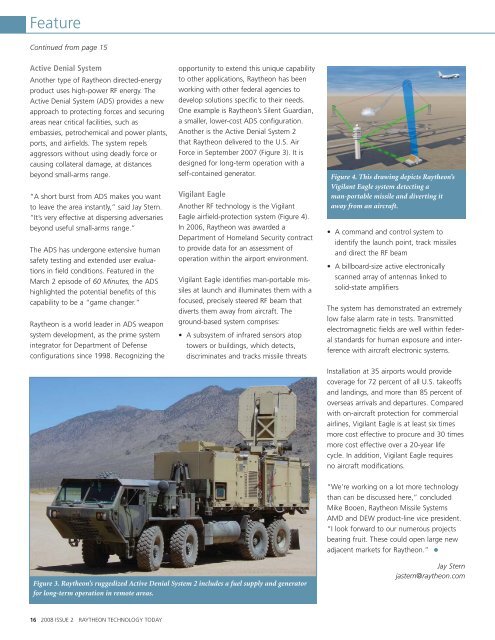2008 Issue 2 - Raytheon
2008 Issue 2 - Raytheon
2008 Issue 2 - Raytheon
You also want an ePaper? Increase the reach of your titles
YUMPU automatically turns print PDFs into web optimized ePapers that Google loves.
Feature<br />
Continued from page 15<br />
Active Denial System<br />
Another type of <strong>Raytheon</strong> directed-energy<br />
product uses high-power RF energy. The<br />
Active Denial System (ADS) provides a new<br />
approach to protecting forces and securing<br />
areas near critical facilities, such as<br />
embassies, petrochemical and power plants,<br />
ports, and airfields. The system repels<br />
aggressors without using deadly force or<br />
causing collateral damage, at distances<br />
beyond small-arms range.<br />
“A short burst from ADS makes you want<br />
to leave the area instantly,” said Jay Stern.<br />
“It’s very effective at dispersing adversaries<br />
beyond useful small-arms range.”<br />
The ADS has undergone extensive human<br />
safety testing and extended user evaluations<br />
in field conditions. Featured in the<br />
March 2 episode of 60 Minutes, the ADS<br />
highlighted the potential benefits of this<br />
capability to be a “game changer.”<br />
<strong>Raytheon</strong> is a world leader in ADS weapon<br />
system development, as the prime system<br />
integrator for Department of Defense<br />
configurations since 1998. Recognizing the<br />
16 <strong>2008</strong> ISSUE 2 RAYTHEON TECHNOLOGY TODAY<br />
opportunity to extend this unique capability<br />
to other applications, <strong>Raytheon</strong> has been<br />
working with other federal agencies to<br />
develop solutions specific to their needs.<br />
One example is <strong>Raytheon</strong>’s Silent Guardian,<br />
a smaller, lower-cost ADS configuration.<br />
Another is the Active Denial System 2<br />
that <strong>Raytheon</strong> delivered to the U.S. Air<br />
Force in September 2007 (Figure 3). It is<br />
designed for long-term operation with a<br />
self-contained generator.<br />
Vigilant Eagle<br />
Another RF technology is the Vigilant<br />
Eagle airfield-protection system (Figure 4).<br />
In 2006, <strong>Raytheon</strong> was awarded a<br />
Department of Homeland Security contract<br />
to provide data for an assessment of<br />
operation within the airport environment.<br />
Vigilant Eagle identifies man-portable missiles<br />
at launch and illuminates them with a<br />
focused, precisely steered RF beam that<br />
diverts them away from aircraft. The<br />
ground-based system comprises:<br />
A subsystem of infrared sensors atop<br />
towers or buildings, which detects,<br />
discriminates and tracks missile threats<br />
Figure 3. <strong>Raytheon</strong>’s ruggedized Active Denial System 2 includes a fuel supply and generator<br />
for long-term operation in remote areas.<br />
Figure 4. This drawing depicts <strong>Raytheon</strong>’s<br />
Vigilant Eagle system detecting a<br />
man-portable missile and diverting it<br />
away from an aircraft.<br />
A command and control system to<br />
identify the launch point, track missiles<br />
and direct the RF beam<br />
A billboard-size active electronically<br />
scanned array of antennas linked to<br />
solid-state amplifiers<br />
The system has demonstrated an extremely<br />
low false alarm rate in tests. Transmitted<br />
electromagnetic fields are well within federal<br />
standards for human exposure and interference<br />
with aircraft electronic systems.<br />
Installation at 35 airports would provide<br />
coverage for 72 percent of all U.S. takeoffs<br />
and landings, and more than 85 percent of<br />
overseas arrivals and departures. Compared<br />
with on-aircraft protection for commercial<br />
airlines, Vigilant Eagle is at least six times<br />
more cost effective to procure and 30 times<br />
more cost effective over a 20-year life<br />
cycle. In addition, Vigilant Eagle requires<br />
no aircraft modifications.<br />
“We’re working on a lot more technology<br />
than can be discussed here,” concluded<br />
Mike Booen, <strong>Raytheon</strong> Missile Systems<br />
AMD and DEW product-line vice president.<br />
“I look forward to our numerous projects<br />
bearing fruit. These could open large new<br />
adjacent markets for <strong>Raytheon</strong>.”<br />
Jay Stern<br />
jastern@raytheon.com
















